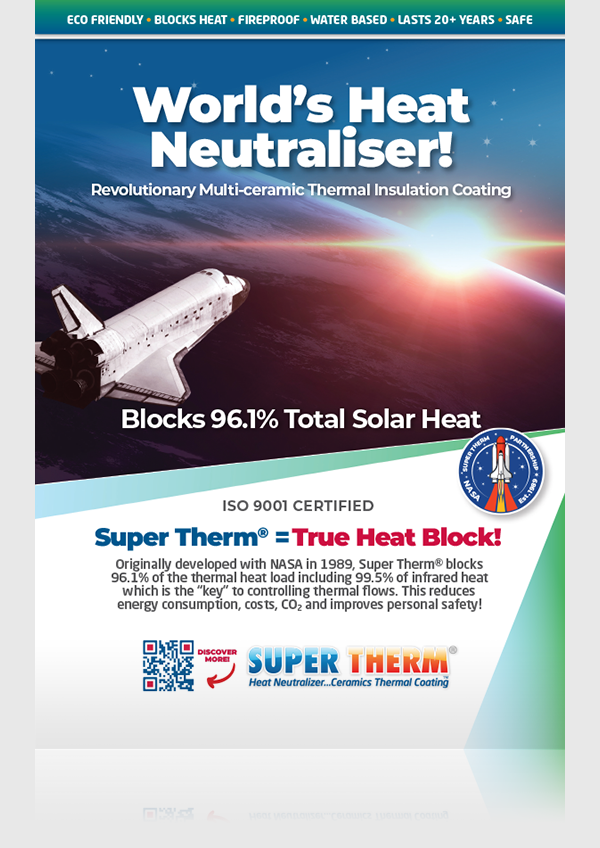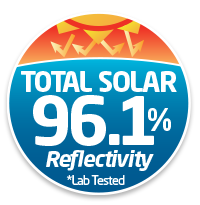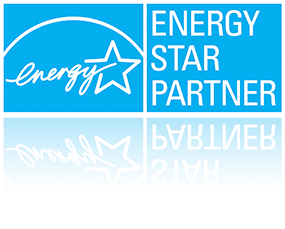Radiant Heat Insulation Barrier Coating for Internal Walls – Super Therm® Thermal Membrane
The Hidden Problem Inside Our Walls: Why Traditional Insulation Fails to Protect Internal Heat
Most buildings and surfaces lose heat the same way they gain it – through radiation. Unfortunately, traditional insulation systems were never designed to handle this dominant heat transfer method. While this is a contentious issue, we have the evidence to back these claims.
1. The Heat Loss Problem: Radiation is Ignored
In cold climates or controlled environments (like modular housing, cold storage, or steel containers), most internal heat loss occurs via radiation, not conduction. Yet conventional insulation — fibreglass batts, rockwool, spray foam – only slow down conductive heat transfer.
What’s worse:
- Fibreglass and rockwool absorb internal radiant heat, then release it outward
- Steel structures (like shipping containers) act as heat sinks, pulling warmth through walls and floors
- Concrete slabs radiate cold air into habitable zones, especially in winter or uninsulated zones
- R-values, the standard for insulation, don’t measure radiation or surface heat behaviour.
According to the ASHRAE Fundamentals Handbook, radiation contributes up to 70% of total heat loss or gain in buildings – a figure ignored by standard insulation metrics.
2. Traditional Insulation Breakdowns
- Loss of performance when wet (reduces R-value)
- No radiant protection in roof, wall or floor assemblies
- Thermal bridging through steel or timber frames
- Space-intensive (minimum 75–100 mm thickness)
- No resistance to condensation or mould
- Degrades over time (slumping, dust, compression, pest ingress)
The Solution: Super Therm® as a Thermal Barrier Membrane
Super Therm® is not a traditional insulator – it’s a ceramic thermal membrane that blocks heat. It was developed with NASA input to block and reflect all three forms of radiation: UV, visible light, and infrared. Applied as a 0.25 mm thick coating, it becomes a high-performance radiant barrier, sealing internal heat inside the building.
How it Works
- Blocks 99% of infrared heat, stopping radiant loss through internal walls, ceilings, and floors
- Does not absorb heat – unlike conventional insulation, it doesn’t become a heat sponge
- Water-resistant, non-absorbent, and acts as a condensation barrier
- Air-tight and fire-rated (Class A, ASTM E84)
- Applied like paint – fast, non-invasive, and space-saving.
Internal Use Case: Shipping Containers and Cold Climate Buildings
Super Therm® has been used extensively to thermally seal shipping containers, military housing, prefabricated homes, and industrial buildings. When applied inside:
- It prevents radiant heat loss through metal or masonry
- On concrete floors or steel ceilings, it stabilises surface temperature, making the space warmer and more energy-efficient
- Unlike foam boards or batts, it adds zero bulk, ideal for small or confined spaces.
What Makes Super Therm® Superior for Internal Use
| Feature | Traditional Insulation | Super Therm® Coating |
|---|---|---|
| Blocks Radiant Heat | No | Yes – 99% IR blocked |
| Thickness | 50 – 150 mm | 0.25 mm (250 microns) |
| Fire Rating | Varies – often flammable | Class A (ASTM E84) |
| Diffusivity Rating | None | 0.256mm2/s (ASTM E1269 on metal plate at 0.25mm) |
| Moisture Resistance | Poor – absorbs water | Excellent – range of tests |
| Air Sealing | Requires additional layers | Yes – Low Permeability (ASTM D1653-13) 8 Perms |
| Performance Degradation | High – compression, moisture | Minimal – 20+ years durability |
| Surface Temperature Reduction | None | Up to 40°C cooler in summer |
| Energy Saving Potential | Moderate | High – 20–50% HVAC reduction |
Thermal Envelope Integration: Super Therm® with Other Solutions
When combined with other efficiency measures, Super Therm® enhances overall performance:
- Double Glazing: Reduces conduction; Super Therm® handles IR radiation on opaque surfaces.
- Bulk Insulation: Super Therm® adds radiant control on top of conductive slowing.
- Thermal Mass Control: Reduces heat absorption of brick/concrete internally.
- Air Tightness & Ventilation: Complements Super Therm® by retaining conditioned air.
Estimated U-Value System Integration
R2.5 Insulation + R0.02 Wall + Super Therm® (R1.5 equiv) = U-value ~0.25 W/m²·K
Standards, Compliance and Certification
Super Therm® supports and aligns with:
- NCC 2022 Section J – energy efficiency performance of building envelope
- AS/NZS 4859.1 – thermal insulation performance compliance
- AS 1530.1 – flammability of materials (Class A)
- ASTM B117 / D870 – salt spray and water resistance (coastal builds)
- Passive House Compatibility – radiant barrier with minimal bulk space
Super Therm® – Comprehensive Internal Use Benefits
Thermal Performance
- Blocks 99% of infrared radiation (ASTM E1269 / E1461): Prevents radiant heat loss from interior spaces
- Retains internal heat in cold climates, reducing heating loads.
- Reduces thermal bridging across steel, timber, and concrete surfaces by forming a continuous barrier.
- Improves U-value of wall systems by contributing ~R1.5 equivalent.
- Maintains stable surface temperatures, even on steel or concrete.
- Insulation without thickness: Just 0.25 mm — saves internal space.
- Enhances performance of existing insulation: Works with batts, boards, or SIP panels by sealing radiant losses.
Condensation & Moisture Control
- Water-resistant surface: Unlike fibreglass or foam, it won’t absorb water or lose performance
- Vapour barrier effect: Stops internal moisture migration into cold substrates
- Reduces surface condensation risk: Especially on slabs, metal walls, and ceilings
- Mould-resistant: Inhibits conditions that cause biological growth in walls.
Energy Efficiency
- Cuts HVAC energy use by 20–50% (field trials and case studies)
- Reduces heating costs by trapping radiant energy indoors
- Minimises peak demand loads on heating systems in winter
- Rapid return on investment: Payback periods under 2 years reported in industrial projects.
Fire & Safety
- Class A fire-rated (ASTM E84): Won’t ignite or release smoke in fire events.
- Non-toxic, low VOC, water-based formulation: Safe for occupied spaces.
- No flammable foam or synthetic filler risk common with PIR or EPS boards.
Installation & Buildability
- No special framing or vapour barriers required: Coats directly onto substrate.
- Fast application: Sprayed or rolled on like paint.
- Perfect for retrofits or modular builds: No need to open walls or ceilings.
- No interior space loss: Ideal for small footprints (e.g., tiny homes, containers).
- Easy to detail around penetrations, ducts, beams, and joins.
Compatibility & Flexibility
- Applies to almost any internal substrate: Steel, concrete, fibre cement, plasterboard, timber.
- Can be topcoated or left exposed, depending on aesthetic needs.
- Works with Passive House and NCC strategies: Bridges radiant gaps in standard insulation plans.
- Improves thermal comfort without changing the building structure.
- Compatible with double glazing, bulk insulation, and thermal mass systems.
Long-Term Value
- 25+ year durability: UV-stable, crack-resistant, and non-degrading.
- No settling, slumping or pest degradation like batt or loose-fill.
- Reduces long-term maintenance from condensation, corrosion, or degraded insulation.
- Sustainable and low-embodied carbon: Lightweight, thin, and long-lasting with minimal waste.
Additional Benefits
- Sound attenuation: Reduces sound transmission by up to 68%.
- Visual comfort: Tinted finishes reduce glare and enhance light diffusion.
- Safe in sensitive environments: Ideal for food storage, data centres, and clean rooms.
- Can be part of a continuous insulation layer (interior and exterior combined systems).
- Supports Green Star and Net Zero strategies through reduced operational energy.
Here’s your expanded comprehensive benefits list for Super Therm® internal use, now with real-world examples and direct source links to back each category. This version is ready for web integration, pitch decks, or technical sales.
Value beyond Price
1. You’re Paying for Performance, Not Thickness
Here’s the straight-shooting truth about why Super Therm® is a high-return investment — not just another expense: Most traditional insulation charges you by the metre — and delivers bulk that often underperforms in real-world conditions. Super Therm® gives you radiant heat protection at just 0.25 mm thickness, doing what 100 mm of fibreglass can’t:
- Blocks 99% of infrared (the main culprit in heat loss/gain)
- Works instantly once applied — no settling, sagging, or moisture issues
You’re not buying fluff. You’re buying proven science.
2. Fast Payback – Typically Under 2 Years
From case studies across Japan, the U.S., and Australia:
- Industrial sites and container units reported 30–50% HVAC savings
- Some saw full ROI in just 12–18 months from energy reduction alone
Case in point:
- A factory in Japan saved $134,000 AUD/year on cooling after Super Therm® was applied.
- ROI: 13.8 months
Source: Shipping Container Insulation Case Studies
3. Reduces Your Future Maintenance Costs
- No sagging, no waterlogging, no pest nests like in batts or foam
- One coat. Two decades. That’s serious durability.
- Slashes corrosion and condensation damage in steel buildings and containers
- Withstands UV, moisture, and thermal stress without degradation
Translation? Fewer repairs, fewer problems, fewer call-outs.
4. Eliminates the “Hidden Extras”
- No framing cavities, no vapour barriers, no internal walls ripped apart
- Cuts down on installation labour and complexity — spray and go
- 0.25 mm = no loss of usable space — especially important in containers, modular homes, and compact builds
5. Adds Value to Property
- Lower running costs = higher energy rating
- Can contribute to Green Star, NABERS, and Passive House certification
- Ideal for tenants, operators, and buyers who care about cost, comfort, and carbon
6. You’re Investing in Heat Control at the Source
Most insulation reacts after the heat gets in.
Super Therm® stops it at the surface — which is the only place that actually matters.
That’s not spending. That’s future-proofing.
Insulation Cost vs Performance Comparison
| Insulation Type | Upfront Cost per m² (Est.) | Space Required | Radiant Heat Block |
|---|---|---|---|
| Super Therm® Coating | $25–$30 (plus application) | 0.25 mm (none lost) | Yes – up to 99% |
| Fibreglass Batts (R2.5) | $15–$25 (plus install) | 90–100 mm | No – absorbs & radiates |
| Polyurethane Foam (50 mm) | $45–$65 (plus install) | 50–75 mm | Low – absorbs heat |
| Foil Board (Reflective) | $25–$35 (plus install) | 25–50 mm | Partial – only under ideal spacing |
Here’s a full cost vs. performance comparison across insulation types, showing how Super Therm® delivers faster ROI, superior radiant control, and unmatched space efficiency.
Conclusion: Why Super Therm® Belongs on Your Interior Envelope
In the 21st century, buildings must actively block heat — not just slow it down. Super Therm® is the only internal-use coating that directly prevents radiant heat loss, cuts energy use, resists moisture, and improves occupant comfort without the bulk, the risk, or the cost of traditional insulation systems.
If your building needs to retain warmth, prevent thermal loss, or seal a steel or concrete structure, Super Therm® is your solution – tested, proven, and built to work at the speed of climate change.









